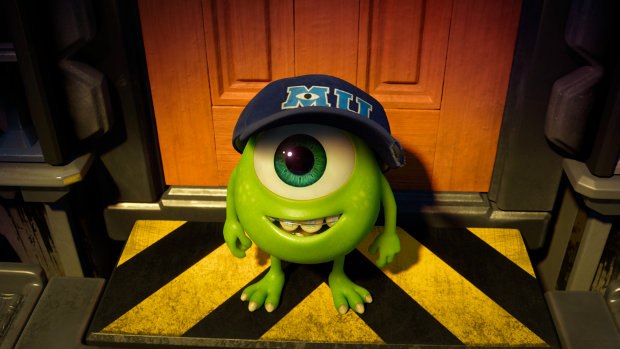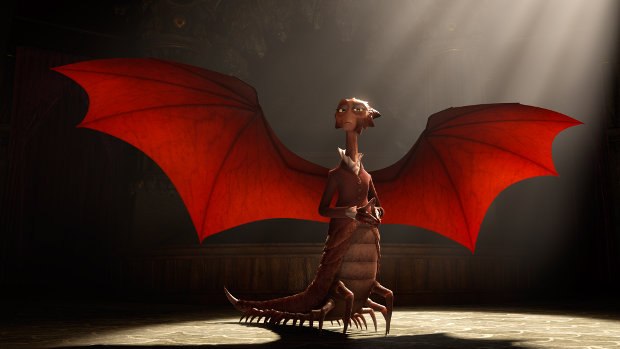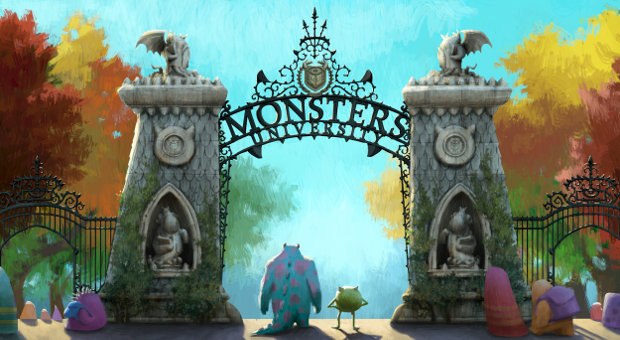The first-time director discusses the dynamics, pressure and satisfaction of helming Pixar’s first prequel.
Dan Scanlon is, first and foremost, a story guy. He relied upon his experience as a writer and storyboard artist to guide him through the often daunting task of directing his first animated feature, Monsters University. Pixar’s first “prequel,” Monsters University treads numerous furry paws and slithering feet across the hallowed ground of Monsters, Inc., one of the studios most beloved films of all time.
From the beginning, Dan and the Pixar creative team were determined to tell a story of personal discovery, of how sometimes reality can be harsh, how the optimism of chasing dreams abruptly ends when we start hitting closed doors. For the director, Monsters University was always Mike’s story, his quest so sincere and compelling. One of the main challenges of course is that with a prequel, everyone knows where the story ends. To make the story enjoyable and rewarding, you have to discover something new about the characters, something not so predictable.
I recently had a chance to talk to Dan both at Pixar’s Emeryville campus as well as at the Annecy Animation Festival in France. He spoke about his directorial faith in a strong story, the immensity of the production as well as his admiration and respect for the hugely talented crew that helped him make the film.
Dan Sarto: There comes a day when you go to sleep “not” the film’s director and then the next evening, you go to sleep “as” the film’s director. Tell me a bit about the dynamic of being chosen to helm such an important Pixar film. You’re now one of a chosen few!
Dan Scanlon: Thanks, yeah. Probably the answer [for being chosen] was my years of story on other Pixar films. I mean, luckily, on Cars, I worked right along with John [Lasseter] and I felt like he and I had a similar sense of humor, a similar sensibility, right off the bat. So I know that I was lucky in that regard. I felt from the very beginning, John trusted me. I mean if you really think about it, I was from Michigan, from nowhere, no real past to speak of. What I love about Pixar and John in particular is that you don’t have to have this big lineage. It doesn’t have to be, well, other places liked him or he’s done this film or that thing. If they like you, if they think you’re funny, if they think you know what you’re talking about, then they like you. I see it all the time now with a lot of young people who are brand new. If they sense this person knows story or this person is funny, they trust them.
That really helped me. Working with Lee Unkrich on Toy Story 3 also was another important thing. Lee is such an important part of Pixar and all their films. Working side by side with him, he also kind of trusted me. Lee also afforded me a little extra peek behind the curtains. I don’t know if this was for grooming purposes or not…I guess it was. I would help him with a lot of things, like recording actors on Toy Story. Lee would direct and I would read opposite the actors. I would go to all the different sessions so that he could focus on directing and not having to read opposite the actors.
As a result, I got to sit and watch Lee direct actors. I got a lot of opportunities to sort of watch and learn and shadow. After that I was a part of the “blue sky” is there an idea here at all group. That was a real honor just to be in the room with Andrew [Stanton] and Lee and Pete [Docter] and John and Dan [Gerson] and Rob [Baird] the original writers, to chime in. Sometime after that. Dan and Rob were working on the film…I was working as well…I guess they just felt comfortable asking me from [to direct], from all those years of working with them.
But it’s funny. I know it sounds ridiculous but I tried not to think too much about the pressure of, “Oh my God I’m the director now!” It felt like a natural progression. I just focused on the story, like “I know how to do this. I’m just ‘in charge’ of it now” and tried not to get too caught up in thinking about that. Just focus on the task at hand. That and I made this film Tracy, which was a live action film. I think they saw that and felt, well, that’s a film I wrote and directed on my own. Though it’s not a billion dollar animated movie, the story is really the hard part and even getting in the ballpark on your own I think was helpful. But I don’t know that I ever set out necessarily to be a director. But it was a thing I liked doing on my own anyway. I always tell kids, if you’re just doing it, you should kinda want to do it if you got paid or not. It’s just something you’ll be doing because you enjoy telling stories.
Dan Sarto: You say you tried not to think about the pressure. But as the film’s director, people are looking to you for all sorts of things. How did you handle the fact that “I’m the go to person – all paths lead through me?”
Dan Scanlon: Again, I think focusing on the story at least made me feel like …
Dan Sarto: You were comfortable there…
Dan Scanlon: Yeah I’m comfortable there. If there’s only one place to be comfortable that’s where you want to be comfortable. Everything else can be answered by the story. You don’t have to know everything about lighting, you don’t have to know everything about character design or even animation. As long as you understand the story you can always look to a much smarter person in the room who is your lead and say, “I just need this moment to convey empathy or sadness or be funny or whatever. This character needs to go from trusting this character to not trusting this character. Help me get there using what you know.” You do that in every department. I remember saying to my wife once, “Boy, sometimes it feels like I’m just telling different people the same thing over and over again.” But that’s exactly what I should be doing. If I’m doing something other than that then I’m doing it wrong. The thing you tell the actor about that scene should be the same thing you tell the animator and the lighter.
You should be consistent…this scene is about sadness…that’s a big part of your job. There are brilliant people [on the crew] who know how to convey sadness. If they are not, then you correct. “I’m not really getting sadness from that.” But sometimes, it’s really as easy as that. I think people complicate it beyond that sometimes because they want to, because…
Dan Sarto: They think they should.
Dan Scanlon: Yeah. To answer your question though, to be the go to guy a lot of times, you just have to keep your cool a little bit, keep it simple so that people can understand what you’re doing. There are times to convey that, “Hey, everything is fine” and then there are times to be honest and say, “You know, I don’t know what I’m doing here. I need your help.” But I learned. Leadership is a really important part of the job, and luckily I had Kori Rae, who is a great leader, and John Lasseter who is a great leader. Sometimes I think you learn more from your managers. An artist, put in this position, doesn’t always know how to be a leader. I had some great managers in the departments too, and you’d learn a lot from them about how to manage personality types and how to be a leader. It’s a big part of the job that I don’t think a lot of people realize at time.
Dan Sarto: Well that’s because most people don’t aren’t in a position to need to worry about those management dynamics. But that’s where a lot of the difficulty in any project comes from…
Dan Scanlon: Absolutely.
Dan Sarto: It’s wrangling and dealing with people. Regardless of how talented and experienced they are, at the end of the day you’re still making a film under a deadline, with a certain amount of people, with a certain amount of resources. Do you ever wake up regretting taking the helm?
Dan Scanlon: Every Pixar movie for sure has a moment where you think, “I don’t think this is a movie.” I certainly had those moments. I mean there were certainly moments where we were in the story room and you watch the movie die on the table. You put A next to B and suddenly none of it lines up anymore. We feel that all the time. It’s a terrible feeling. I’m not exactly sure that there was a moment where we thought, “This is definitely gonna work.” But it does feel like when we’re lucky, there's usually a screening where everyone says, “That’s your story.” You try a bunch of stuff, but there's a moment where you say you’ve got the bones of it now. When we realized this was Mike’s story and not Sulley’s, that was a big deal because we had our throughline and our heart. When we added the Oozma Kappa team and they started to really work with Mike and Sulley, that was a big moment of, “There's something to this that’s really worth making…and is working.”
Dan Sarto: Describe the dynamic of deciding when a scene is done. No more iterations.
Dan Scanlon: That’s where I learned a lot from Kori, something she does really well, balancing that out. So much of making a movie too is about choosing your battles. Sometimes realizing that this is just going to take more work. Gauging that as you go. Luckily I work at a place with really talented people so when you make a choice to let something go it probably looks pretty good. Near the end anyway, it’s about morale and keeping people’s energy up. You don’t want to be the person that’s iterating over and over again on something that just frankly doesn’t matter. Again, I always go back to the story. How big a story point is this? How great does this really have to be to convey the idea? I worry more sometimes about spending the energy of people rather than spending money.
And I think you want them to know that you’ve got that in mind. I’m not spending tons of time crafting a perfect water bottle that’s in the background of a scene or that doesn’t really matter in the scene. Even with jokes, frankly, sometimes I think you can fall down a pit with a joke and you have to ask yourself is this more important than a story point that we really want to spend this time with later? But again, luckily I could always look to my leads. I would ask, “Is this hard to do? Is this easy to do?” so that you could justify whether or not it was worth doing, just trying to keep people’s momentum and energies right.
Dan Sarto: Just because you can do something doesn’t mean…
Dan Scanlon: …doesn’t mean it’s worth doing. Luckily, I felt like you said, story was one of my comfort zones. But as you get out of your comfort zone, you really look to the support of everyone around you to make sure you’re making choices in an intelligent way. It’s a marathon and you want to keep everybody excited and passionate and not wear them out. But story is hard in that, like you said, you only have a certain amount of iterations and sometimes you have to do those iterations faster even though it’s difficult. But that’s a place where I think, sometimes sadly for the story team, it is worth it. It affects everything down the road. We’ve got to get the story just right even if it means working later hours and working faster and a little harder. I’d rather spend that energy there because it’s going to matter so much more later on.
Dan Sarto: Looking back on the production, what would you say were the biggest challenges you faced?
Dan Scanlon: Well in the most general way, definitely the story. Because it was a prequel. The prequel added an extra little layer of complication. It was something we hadn’t dealt with before, something that almost at times felt unfair to the story. At one point we were saying, “Crafting a story is like this balancing act where you’re balancing this house of cards and every now and then it falls down. A prequel, it’s like you’re balancing this house of cards and every once in a while a little kid with ‘Prequel’ or ‘Predictability’ written on his shirt comes and knocks them down unfairly.” You just feel like, “Oh the story only worked because we know the ending.” That was definitely hard.
And then the size of the film was tough. It’s this huge world, not just with a crowd of people but with a crowd of monsters. They all have to be very diverse. So their rigs are different. That was very complex. Then, it’s also a big cast. Even from the writing point of view you’ve got a lot of different characters and personalities to deal with. But again, definitely, without question, the story was the hardest part. But it was also the most rewarding in the long run. It’s not always big laughs in the story room, even getting to jokes sometimes. It can be such a grueling process because “fun” comes out of it.
Dan Sarto: Plus, it’s hard to be funny. There are a lot of lazy ways that you can get a laugh, but that doesn’t mean it’s worth sharing with anybody besides your annoying friends. Switching gears a bit, were there any tech advances that came out of this film?
Dan Scanlon: Um, backpacks apparently. At one point, we were talking with the simulation department and they said backpacks are really hard, especially on fur. And I thought, “Really?” So there are backpacks in the movie, but apparently they’re very difficult. Not as sexy as water and hair and explosions. But that was one thing. The other thing was just the size of the movie. On the first Monsters we couldn’t have that many monsters in the background. This movie was set in a college. So we had to fill it with every kind of monster, which was also kind of difficult. They all use different rigs and set ups, tentacled ones, sliding slugs. And so the scope of the movie was the trickiest part. We also had great technological breakthroughs with the lighting. This was a movie we did for the first time with Global Illumination, which is this software that allows the film to look richer. That was a big leap forward on this movie.
Dan Sarto: With the film about to open, looking back, what about this production gave you the most personal sense of satisfaction?
Dan Scanlon: Honestly, just seeing everybody’s work pay off. As I’m hearing people say they like it, I just feel the pride of all 250 people that worked on it. You see all their hard work. That’s the big gamble for me. All these people are working really hard, doing good work. If this doesn’t work then you feel a little bit like it’s your fault. So to see the pride that they can have in their work really makes me happy. Also, to see the pride of the people that didn’t work on it at the studio. To see them excited, people I didn’t even see while working on it, it’s a thing that you can share. After the fact, it’s looking at all those little decisions that people made in the movie, to see them paying off so they can point that out to their spouse or their kids and say, “I did that.”
--
Dan Sarto is editor-in-chief and publisher of Animation World Network.
Dan Sarto is Publisher and Editor-in-Chief of Animation World Network.














